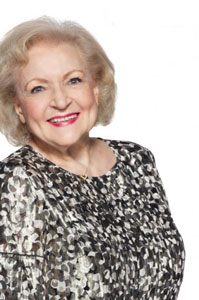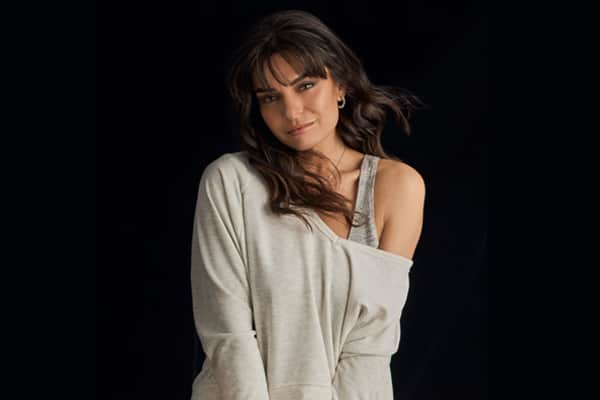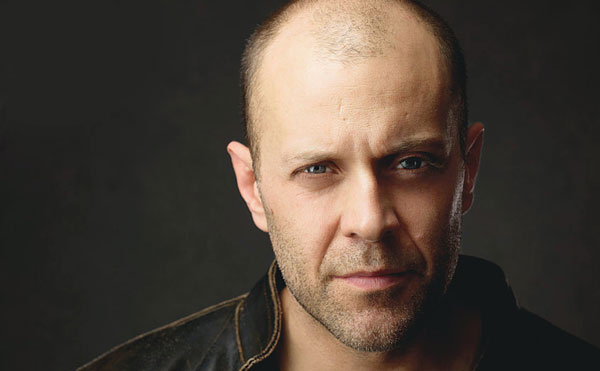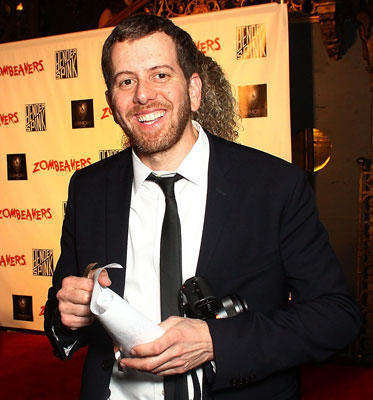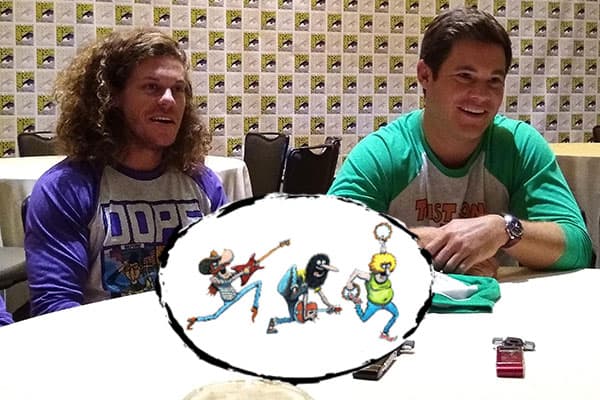
Adam Devine and Blake Anderson were at this summer’s Comic-Con to promote their upcoming animated series, The Fabulous Furry Freak Brothers. The show, based on the 1960’s Gilbert Shelton comic book classic, features three hippies from the 60’s who wake up in today’s San Francisco and it’s that fun “juxtaposition” that appealed to them, Devine said.
In this interview, Devine and Anderson (along with showrunners Alan Freedland and Alan Cohen) talk about how they got involved in the show, voice acting and how streaming services have opened up a “creative boom.”
This is an older comic. How did you find it? What made you want to turn it into an animated show?
Alan Freedland: Well, the producers, Mark Canton and Courtney Solomon found the property and they’re big fans of it from the old days, as we all were. And we thought we could modernize it by taking these freaks from 1969, have them smoke something that’s a little bit off kilter and they wake up 50 years later in 2019.
Adam Devine: And it’s cool. It’s cool like seeing the world through the lens of these guys from the ’60s. Obviously the world has changed so much and San Francisco specifically has changed so much where it’s like fully gentrified now. Everyone is super progressive. It’s like the most woke place on earth and to take these guys that are ‘hippies from the 60s and put it in this world, it’s the juxtaposition is just inherently fun.
Blake Anderson: Yeah. And then at the end of the day, it’s just kind of the story about three broke friends who are just trying to get by and stay high.
Adam Devine: You know, we did Workaholics obviously for seven seasons. And, when I found this property… Blake actually showed me the comic and I was like, “Oh, this is incredible. This is so good.” And, then I was like, “Wait, this could be a show.” And then the producers reached out to us and it just happened so organically that we were reading the comics as they approached us. And, I was like, “Oh, we know these archetypes, these three guys.” We just came from a show, three guys, three archetypes, and we know how to develop these stories. And these guys have done such a great job writing the show with our voices.
Will counter-culture people 60’s people be really that much different from current San Francisco people?
Adam Devine: Yeah. [laughs]
Blake Anderson: Well, what’s weird is even if you go back and read the old comics, a lot of them still hold up. Like, the things they’re talking about is just like, “Wow, we haven’t come that far.”
Adam Devine: It is cool to see how cyclical everything is. Like, they were rallying against big Pharma and big corporations and you’re like, “Oh yeah, that’s kind of what we’re still rallying against.”
Is it the same look as the old comics?
Blake Anderson: We’ve gone pretty similar to that look, as far as the character designs. The backgrounds may be a little more realistic. Gilbert Shelton liked to have the background sort of warped a lot, that sort of sixties kind of psychedelic feel. We’re moving a little bit away from that background wise, but the characters themselves will look very much the same.
What were some of the challenges of adapting a comic strip to a cartoon?
Alan Cohen: When you say adapting, we’re not doing all the same stories. We’re sort of taking the character, which includes these three main guys and their cat. And then we’re looking at, you know, situations that exist today. Like we have one episode that features, they live in San Francisco, which is basically an extension of Silicon Valley now. So that’s completely different. And we have one episode that features a robot brothel, which we had read about. The Silicon Valley guys are basically, you know, so anti-social that they’d rather be with robots than real people. And we have one of our guys, they have no idea what robots are, right? So he ends up dating one and not realizing until like halfway through the episode that he’s dating a robot. And he also prefers it. That was never in the comics, but that’s sort of the same sort of theme of these guys who were never really that good at connecting with women and what’s our modern take on it.
Blake Anderson: And I think with anything when you’re adapting something that has like a really cool and core fan base, I think the main goal is you just don’t want to piss off the day one fans or whatever.
Alan Freedland: Yeah, we’ve all kept the characters true to who they were back then. Phineas is a conspiracy theorist and that works back in the 60s and it works now.
I know you guys have done animated characters before but what’s appeal to do a voice character work? Is it just like a blast to do?
Adam Devine: It’s so fun, it really is. On a set, on like a movie set or a TV set, you get a few shots at it and then you have to move on because the setup takes so long and the lighting and all this other stuff that isn’t the acting. But with voice acting, there’s no setup. They just record and you just keep going. And so you’re able to try different things and improv a lot and do alternate takes and you’re able to get it exactly kind of how you want it.
Blake Anderson: Yeah. You can make some really stupid decisions and it’s fine.
Adam Devine: Yeah, they’re like, “Just do it again. Don’t do that again, but do something else again.”
Are you guys using your actual voices or like something more charactery? Like, will we know it’s you?
Adam Devine: I think so.
Blake Anderson: I think it’s impossible to not know my nasally voice.
When you saw the characters were you drawn to any of them? Did you call dibs on any of them?
Adam Devine: Yeah. But we’re not saying who we are quite yet because we’re still arguing about it. We still have to fight to the death.
Blake Anderson: Not everybody can be Freddy, I get it.
It seemed like there was a time a few years ago where animation was on a down swing. But now, it’s popular again.
Adam Devine: I think that’s exactly right. I think like the streaming services have breathed a breath of fresh air into the whole industry because you’re able to do what you want. A more ‘R’ rated or a more mature cartoon can’t be on Fox. Like you can’t go all the way on a network because they have to sell ad revenue, you know? They have to sell ads to Buick or whatever. So, what’s great about different streaming services is that you are able to do whatever you want. And I think that bodes well for creativity and I think that’s why it’s having such a boom right now.
Is the show going to be more R-rated?
Blake Anderson: Yeah. I also think, just like with the generation that we grew up in, we were so immersed in cartoons that like, it’s not very foreign to us. Like, we want to watch cartoons and the fact that they’re now being an adult is like, “Oh, cool.”
Adam Devine: I feel like people, yeah, that are our age, that are… We are adults now. I think exactly what Blake said, we’ve grown up with it and now we want to see cartoons that are more to our adult sensibilities.
Blake Anderson: And that show nudity.
I’m very intrigued by streaming media and how it’s really opened the doors for a lot of new types of content. So from your perspective, how easy is it to pitch projects now?
Alan Freedland: Well, has it gotten easier? It’s just more places that you can take your Willy Loman and take your briefcase to.
Alan Cohen: Broadcast networks, the name broadcast, right? It has to be oriented towards a broader group of people because there’s so many watching with these streaming services. If you can pitch something like, Big Mouth that’s there now, they know that the audience for that willl find it on Netflix. It isn’t like it’s airing at 8:00 PM so everyone has to be there. So it’s made it easier to pitch something that’s more specific like what we have. There’s a lot of competition for that space still on Netflix or Hulu or wherever. So it’s not necessarily easy to sell something, but it’s easier to have a more specific and unique material.
Adam Devine: And I think that’s why there is such a creative boom right now is because you are able to be more specific and that’s what works so well. Like specificity is what works so well in comedy.
What’s the one thing you want people to know about this show?
Adam Devine: I honestly think people are gonna laugh their ass off at this cartoon. And I want people to know that this is a safe space to come and laugh your ass off.

